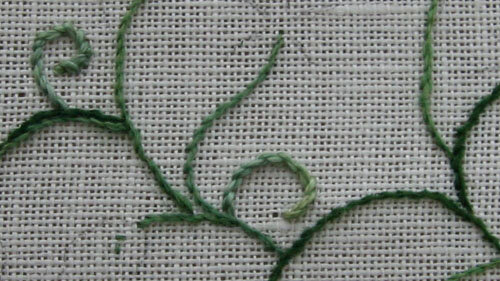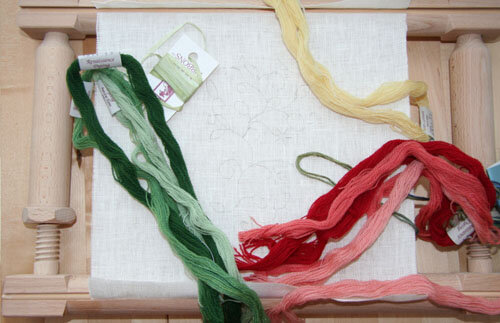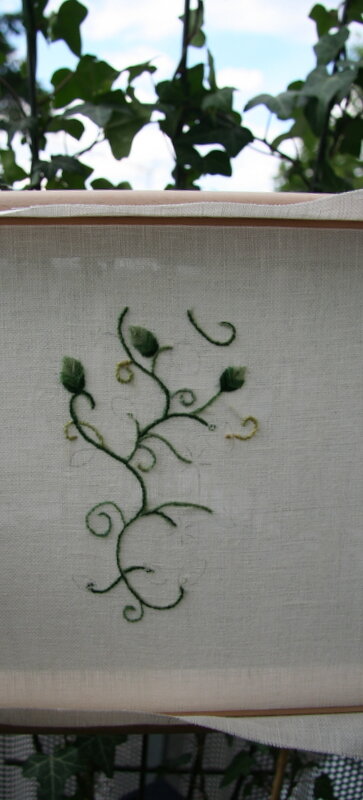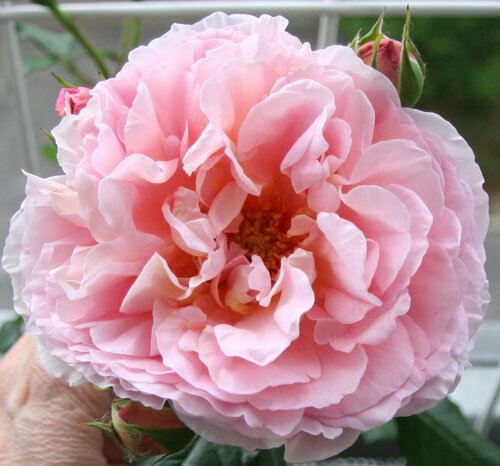Stitching on linen again
It's been quite a while since I've stitched on plain linen. The last two large pieces I finished were both crewel pieces worked on linen twill. The cap is being stitched on a dense cotton even weave fabric. (I don't know what it is as I got it at a fabric market and didn't ask in the crush of people.) The goldwork sampler is on muslin backed silk. None of these fabrics has "holes" in them. What do I mean by holes? The tiny spaces between the warp and weft threads of linen. The project I started Saturday morning calls for cream linen. When I began to trace the sweet, simple pattern, I noticed that my pencil didn't move as smoothly across the linen as it had across the twill or the silk or the mystery cotton. It isn't a problem, I just noticed it more than I had before.While stitching, I had to think about where to put my needle so I avoided the holes. Again, not a problem since I could split the fiber to put the needle exactly where I wanted it to be, but a different way of working than I'd experienced for a while.This is one of the things I love about embroidery: the wide variety of materials and techniques available to us. This new little project on linen worked with Renaissance Dyeing wool, one shade of Caron Watercolors thread and one shade of Thread Gatherer ribbon. Pieces that mix threads are always so much fun to work on and so interesting to look at when they're finished.
The project I started Saturday morning calls for cream linen. When I began to trace the sweet, simple pattern, I noticed that my pencil didn't move as smoothly across the linen as it had across the twill or the silk or the mystery cotton. It isn't a problem, I just noticed it more than I had before.While stitching, I had to think about where to put my needle so I avoided the holes. Again, not a problem since I could split the fiber to put the needle exactly where I wanted it to be, but a different way of working than I'd experienced for a while.This is one of the things I love about embroidery: the wide variety of materials and techniques available to us. This new little project on linen worked with Renaissance Dyeing wool, one shade of Caron Watercolors thread and one shade of Thread Gatherer ribbon. Pieces that mix threads are always so much fun to work on and so interesting to look at when they're finished. The design is by Barbara Jackson of Tristan Brooks Designs from Issue 67 of Inspirations magazine. This will be the cover for a brand new needle case for all my needles, made especially for the RSN Goldwork course this summer. It should work up really quickly as it isn't a large project and (most importantly!) the stitches and threads are all decided for me. I won't be spending time pulling out stitches on this project!Tristan Brooks designs are always lovely and the color combinations so pretty; they are fresh and classic at the same time. Later, I walked out onto the terrace and noticed that the vine and leaves were strikingly similar to the real thing growing next to my favorite bench.
The design is by Barbara Jackson of Tristan Brooks Designs from Issue 67 of Inspirations magazine. This will be the cover for a brand new needle case for all my needles, made especially for the RSN Goldwork course this summer. It should work up really quickly as it isn't a large project and (most importantly!) the stitches and threads are all decided for me. I won't be spending time pulling out stitches on this project!Tristan Brooks designs are always lovely and the color combinations so pretty; they are fresh and classic at the same time. Later, I walked out onto the terrace and noticed that the vine and leaves were strikingly similar to the real thing growing next to my favorite bench. The stems are done in stem stitch and the shades of green vary from one section to another. (Renaissance Dyeing #1617, #1612 and# 1511) The instructions are to use two of the three shades of green side by side for any one part of the vine, changing the shades of green from one section of the vine to another. This shift of shade makes them look quite realistic. The leaves are done in fly stitch, dividing each leaf into three sections, each done in a different shade of green. The tendrils are stem stitch again, but now done in the Caron Waterlilies thread, so the color shifts over the length of the tendril. (Caron thread #076 Woodlands).
The stems are done in stem stitch and the shades of green vary from one section to another. (Renaissance Dyeing #1617, #1612 and# 1511) The instructions are to use two of the three shades of green side by side for any one part of the vine, changing the shades of green from one section of the vine to another. This shift of shade makes them look quite realistic. The leaves are done in fly stitch, dividing each leaf into three sections, each done in a different shade of green. The tendrils are stem stitch again, but now done in the Caron Waterlilies thread, so the color shifts over the length of the tendril. (Caron thread #076 Woodlands). While I was on the terrace i couldn't miss the chance of snapping a photo of our first rose of the summer. It's a David Austin English rose named Abraham Darby. Isn't it just beautiful? And the smell... No matter how beautifully we stitch, we may come close to - but won't ever top - nature.
While I was on the terrace i couldn't miss the chance of snapping a photo of our first rose of the summer. It's a David Austin English rose named Abraham Darby. Isn't it just beautiful? And the smell... No matter how beautifully we stitch, we may come close to - but won't ever top - nature.
